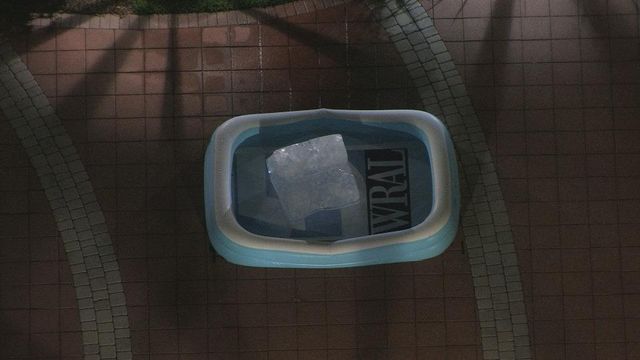Lots of calculations to predict when WRAL ice will melt
Science is everywhere, even in a kiddie pool outside the front door of the WRAL Studios where more than 1,800 pounds of ice is currently melting.
Posted — UpdatedScience is everywhere, even in a kiddie pool outside the front door of the WRAL Studios where more than 1,800 pounds of ice is currently melting.
It’s been there since Todd Dawson arrived around 4:30 a.m. By 6 a.m., it was ready for its big debut.
Melting occurs when the energy taken out of the water to freeze it is returned. Ambient heat in the air, increases in surface temperature from sunlight as well as heat in the water surrounding the block return energy to the ice, changing its state back to liquid. Other factors including wind, any precipitation and heat transferred from below will affect the melt time, though the ice is resting on a sheet of foam core which provides some insulation.
We can make reasonably accurate predictions about the changing temperature Thursday. As long as the sun is up, the surface of the sculpture will receive additional energy in the form of sunlight. Thursday's overcast skies will temper that energy though and cloud cover is difficult to predict on the small scale required here. Wind will also impact the rate of ice loss, not just to melting but will also cause some of that water to evaporate.
Another factor you may not have considered is the sculpture’s location, less than 200 feet from busy Western Boulevard. The sculpture is also adjacent to the entrance to a building and will be passed by hundreds of Capitol Broadcasting employees and visitors throughout the day. Each will kick up dust, known to absorb sunlight. When deposited on the sculpture that dust will radiate that heat.
On a much larger scale, recent research found that dust and soot, particularly from forest fires in Russia and North America, were among the main drivers for a significant melt event. In 2012, 97 percent of the Greenland ice sheet experienced melting. This widespread of a melt event had not been recorded since at least 1889.
So, how long will it take for the 50-pound WRAL logo plus the 1800-pound base to melt? After just 3 hours the WRAL logo was mostly gone, but that serif font has a lot of surface area. The larger block will take much longer, but any ice submerged in water in the pool, both from melted ice and any precipitation will melt faster because water is a much better conductor of heat energy than air – about 20 times better.
With all of that plus the forecast for Thursday and Friday, I’m going to guess the entire block will take a total of 24 hours to melt.
Why my estimate could be wrong
All measurements above are approximate, and I made a lot of assumptions, perhaps too many. Before the sculpture even had its big debut, the WRAL logo started dripping, so the actual start time is difficult to pinpoint. Also, the ice is doused with water to clear off any shavings or tool marks, which immediately raised its surface temperature and hastened melting.
The biggest challenge in estimating when this sculpture will complete its transition to puddle is the abundance of variables, most of whih can only be predicted within a few percentage points at best. Any precipitation we might get on Thursday is very difficult to predict and could have a big impact.
At some point, the ice will crack, maybe even shatter. This will increase the surface area and hasten melting. When and how much remains to be seen.
Will the pool overflow?
Another interesting question that Mr. Hamstra’s 5th grade math class took on while watching the ice melt online today is: will the kiddie pool overflow?
The inside of the pool measures approximately 100" x 70" x 25" a volume of about 100 cubic feet. This is very approximate because the bulging sides of this inflatable pool will reduce that volume, but we’ll ignore that for now. It takes approximately 1 pint of water to make 1 pound of ice. The 50-pound WRAL logo along with 1,800-pounds of ice in the base required approximately 230 gallons that will melt down just over 30 cubic feet of water to the pool.
The completely melted sculpture will not overflow the pool.
But what if it rains? The surface area of the pool is 48.6 square feet, so an inch of rain would add just over 4 cubic feet to the pool (assuming no evaporation). I think the WRAL meteorologists will back me up in predicting that 17” of rain is unlikely before this experiment is over.
Copyright 2024 by Capitol Broadcasting Company. All rights reserved. This material may not be published, broadcast, rewritten or redistributed.






